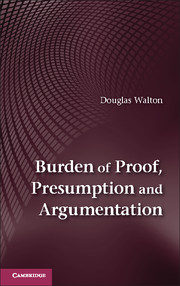Book contents
- Frontmatter
- Dedication
- Contents
- Acknowledgments
- 1 Introduction to Basic Concepts and Methods
- 2 Burdens of Proof in Legal Reasoning
- 3 Presumption in Legal Reasoning
- 4 Shifting the Burden of Proof in Witness Testimony
- 5 Burden of Proof in Dialogue Systems
- 6 Solving the Problems of Burden of Proof
- 7 Burdens of Proof in Different Types of Dialogue
- 8 Conclusions
- Bibliography
- Index
5 - Burden of Proof in Dialogue Systems
Published online by Cambridge University Press: 05 July 2014
- Frontmatter
- Dedication
- Contents
- Acknowledgments
- 1 Introduction to Basic Concepts and Methods
- 2 Burdens of Proof in Legal Reasoning
- 3 Presumption in Legal Reasoning
- 4 Shifting the Burden of Proof in Witness Testimony
- 5 Burden of Proof in Dialogue Systems
- 6 Solving the Problems of Burden of Proof
- 7 Burdens of Proof in Different Types of Dialogue
- 8 Conclusions
- Bibliography
- Index
Summary
In his book on fallacies, Hamblin (1970) built a simple system for argumentation in dialogue he called the Why-Because System with Questions. In his discussion of this system, he replaced the concept of burden of proof with a simpler concept of initiative, which could be described as something like getting the upper hand as the argumentation moves back and forth in the dialogue between the one party and the other. No doubt he realized that the concept of burden of proof was too complex a matter to be dealt with in the limited scope of his chapter on formal dialogue systems. In this chapter, it is shown how an extended version of Hamblin’s dialogue system provides a nice way of modeling the phenomenon of shifting of burden of proof in a dialogue, yielding with a precise way of distinguishing between different kinds of burden of proof, and dealing with fallacies like the argumentum ad ignorantiam (argument from negative evidence).
Over forty years has passed since the publication of Hamblin’s book Fallacies (1970), and there has been much written on the subject of argumentation since that time. One might think that such a book would have long ago ceased to have much value in contributing to the latest research. Such is not the case, however, especially with regard to Hamblin’s remarkably innovative Chapter 8 on formal dialogue systems, a chapter that provided the basis for much subsequent work. To give an example of a formal dialogue system of the kind he recommended in Chapter 8, he built a Why-Because System with Questions. A leading feature of this system is that it has a speech act representing a move in a dialogue in which one party asks the other party to prove, or give an argument to support a claim made by the first party. The Hamblin system has several rules for managing dialogues in which such support request questions are asked, and need to be responded to. It is shown in Chapter 5 how these rules are fundamentally important in attempting to build any formal dialogue system designed to be a framework modeling the operation of burden of proof in rational argumentation.
- Type
- Chapter
- Information
- Burden of Proof, Presumption and Argumentation , pp. 145 - 175Publisher: Cambridge University PressPrint publication year: 2014



